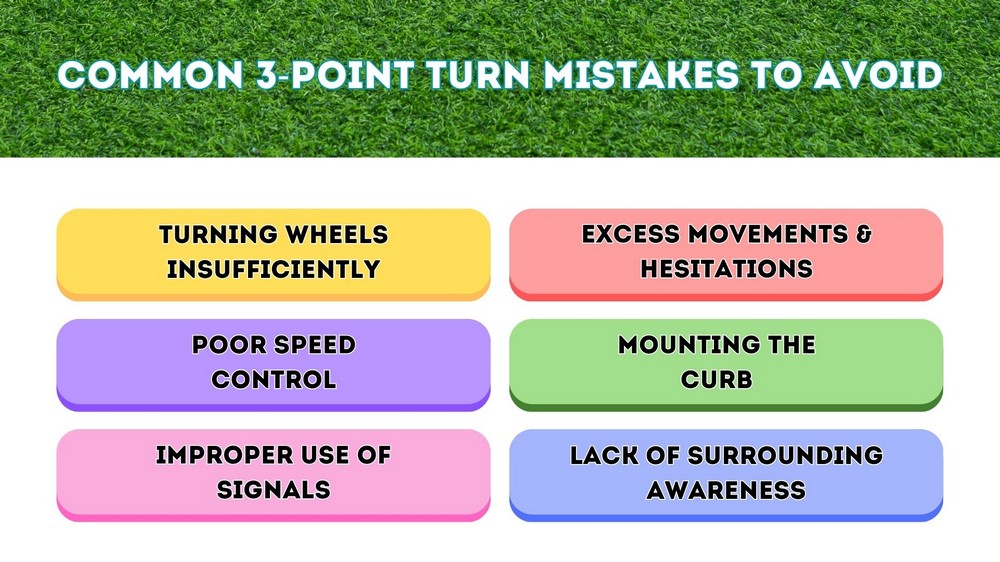How to Ace the 3-Point Turn in Your New York Driving Test

Table of Contents
Getting your driver's license is a rite of passage for teenagers across New York. While learning to drive opens up new horizons, the road test can be daunting for many beginners. One maneuver that strikes fear into the hearts of NY drivers-in-training is the tricky 3-point turn.
Mastering this complex sequence of turns in a narrow space is a must for passing the New York DMV driving test. Examiners pay close attention to how you set up, position your car, and check your surroundings when attempting this common real-world driving procedure.
This comprehensive guide breaks down everything you need to know for nailing 3-point turns during your exam. You'll learn insider tips and techniques to smoothly perform this maneuver while impressing the examiner with your car control skills.
We’ll take you through what to expect for 3-point turns in the New York driving test, a step-by-step process to execute them flawlessly, common mistakes to avoid, and key pointers to finally take the stress out of this critical test component.
With information straight from the NY DMV handbook and insights from professional driving instructors, you'll gain the confidence to ace your road test 3-point turn when the time comes. So buckle up and get ready to put this essential skill in your back pocket!
Understanding the 3-Point Turn
Before diving into how to perform a 3-point turn, let's quickly cover the basics of what this maneuver is all about.
See where can I rent a car for driving test in Brooklyn with our map of local rental locations.
What Is a 3-Point Turn?
A 3-point turn, sometimes called a K-turn or Y-turn, is a driving technique used to turn your vehicle around in a narrow space when you can't make a simple U-turn. It requires you to move forward and backward in a sequence while turning your steering wheel to complete a 180-degree change in direction using just the road width available.
This controlled maneuver allows you to go from facing one direction to the exact opposite within a few moves. Think of those times when you need to abruptly pull into a driveway or side street, but have to turn back around to return where you came from.
Mastering 3-point turns gives all drivers vital flexibility in restricted spaces.
New York DMV Requirements
The New York DMV road test examiners will assess how you execute the 3-point turn within the following standards:
- You must complete the turn using a maximum of 3 movements (forward-backward-forward)
- Your vehicle should not mount the curb at any point
- You must maintain full control of the vehicle
- Situational awareness through checking mirrors and blindspots is mandatory
Making more than 3 moves or bumping onto territory outside the allotted road space constitutes an automatic failure.
Why 3-Point Turns Matter
While the 3-point turn is specifically tested for getting your license, having this skill pays dividends for all drivers:
- Gets you out of a jam when you need to turn around on narrow residential streets
- Allows a mid-maneuver correction if you make a wrong turn
- Comes in handy when you need to briefly pull into driveways or side roads during a trip
- Helps park on tricky inclined roads or entranceways
With an understanding of what the 3-point turn involves and how the NY DMV evaluates it, you can now follow our step-by-step guide to consistently nail this pivotal test requirement.
Mastering the 3-Point Turn: Step-by-Step Guide
Now let's walk through executing the 3-point turn correctly from start to finish. Follow these key steps and techniques for DMV road test success:
Proper Setup & Positioning
Pick a Safe Location: Choose a side road or low-traffic area so you can take your time when first attempting this. Never perform a 3-point turn on busy, higher-speed streets.
Prepare Your Car: Activate your right turn signal early to indicate you'll be pulling over. Move closer towards the curb on the far right when space allows.
Ensure Clear Roadways: Scan mirrors thoroughly before initiating your move, including blindspots over both shoulders. Traffic must be fully clear in both directions first.
Point #1: Turn Left Across
Indicate & Turn Left: Now activate your LEFT turn signal. Then while continuing to check mirrors, turn your steering wheel completely counter-clockwise.
Roll Across: Allow your car to slowly inch forward diagonally until your front bumper reaches the opposite curb or edge of the left lane. Use fixed points like lamp posts as targets.
Straighten Wheels: At your maximum extension across the road, straighten your wheels briefly while keeping the car stationary.
Point #2: Reverse Back to Midpoint
Look & Signal Right: Check surroundings again for other vehicles. Turn the signal to the right position before the next move.
Crank Wheel & Reverse: Turn steering wheel completely CLOCKWISE now. Verify over both shoulders first, then carefully reverse halfway back across the street to around the midpoint.
Straighten Again: With your car positioned laterally on the road, straighten wheels quickly while the brake pedal remains depressed.
Point #3: Pull Forward to Finish
Indicate Left to Exit: After full traffic checks, activate the left turn signal again indicating your exit from this maneuver.
Crank Wheel & Accelerate Out: Turn steering all the way to the left again to straighten out. Then simply accelerate forward in a controlled manner back into the proper lane and traffic flow.
Helpful Tips & Tricks
- Use 3 moves only with no added corrections
- Maintain slow, steady speeds throughout
- Pick reference points to gauge position
- Take it wide on initial left turn out
- Keep wheels straight when stationary
With our detailed guidance, you now have all the tools to master DMV-approved 3-point turns for your upcoming New York road test. Stay calm, focus on each step, and visualize succeeding. You’ve got this!
Call Us Today 6AM-10PM
Or fill out the form 24/7
Our team is here to guide you with promotions, instructor availability, and the best training package for you.
Common 3-Point Turn Mistakes to Avoid

While mastering the sequence of the 3-point turn, many student drivers struggle with the same pitfalls. Being aware of these slip-ups and actively working to correct them is key to checking this box on your NY road test evaluation.
Turning Wheels Insufficiently
Failing to crank your steering wheel fully at each stage of the turn limits your maneuverability. Max out left and right turns until wheels hit their stops for the sharpest possible turns.
Poor Speed Control
Approaching each driving stage too quickly or slowly demonstrates lack of control to examiners. Maintain safe crawl speeds throughout with no sudden accelerations.
Improper Use of Signals
Forgetting to activate your turn signals, using them incorrectly, or neglecting mirror checks translates to inadequate safety awareness. Stick to signal discipline procedures.
Excess Movements & Hesitations
Each extra pull forward or backward after the core 3 further blocks traffic flow. Decisively progress through each element as trained without nervous wavering motions.
Mounting the Curb
Drifting tires onto sidewalks or verges conveys sloppy technique plus car positioning awareness. Use your mirrors to stay centered during reverse segments.
Lack of Surrounding Awareness
Allowing other cars or pedestrians to appear and pressure your move shows poor observational skills and decision making. Ensure 360 degrees of clear space first.
With better understanding of these common missteps,drivers can spotlight their personal weaknesses and troubleshoot using our in-depth 3-point turn guide. Identify your struggle points now to conquer them well ahead of your NY road test day!
Additional Resources & Practice Tips
With our comprehensive guidance, you're well on your way to 3-point turn excellence on your NY driving test. But cementing your skills requires applying our tips during hands-on practice.
Official New York DMV Resources
Bookmark the DMV's driver's manual and road test criteria pages for on-the-go access to state-approved procedures:
- NY DMV Driver's Manual - Study 3-point turn section
Find Practice Spaces
Identify large, empty parking lots or quiet suburban side streets on which to rehearse. Place traffic cones or solo cups to simulate road edges and targets.
Enlist an Instructor
Schedule periodic 3-point turn refreshers with your driving school instructor if available. Their experience spotting small mistakes and tips for improvement can prove invaluable.
Remain Confident on Test Day
On exam day, remember to breathe and take your time when directed to perform the 3-point turn. Avoid overthinking each staged move. Let our tips and your preparation shine through.
With a growth mindset geared towards constructive feedback, every practice run brings you closer to executing 3-point turns that wow evaluators. You’ve got the tools; now display your skills with confidence!
Find out if I can use a rental car for my road test and which rental companies allow DMV testing.
Call Us Today 6AM-10PM
Or fill out the form 24/7
Our team is here to guide you with promotions, instructor availability, and the best training package for you.
Conquering the Infamous Driving Test 3-Point Turn

Earning your driver’s license is a major milestone for New York teenagers. While learning to drive opens up exciting independence, the pressure to pass your road test can be intense.
One maneuver that strikes fear into NY drivers-in-training is the intricate 3-point turn. Completing this sequence of turns in a narrow space with precision is pivotal for DMV exam success.
In this guide, we broke down everything you need to master the 3-point turn for your upcoming driving test. You learned insider tips and techniques to smoothly set up, position your vehicle, check your surroundings, and confidently execute this common real-world procedure.
Now you understand what’s involved, from studying the NY driver’s manual to finding empty practice lots. We walked through conquering each cranking wheel turn while avoiding driver's permit pitfalls. Our bonus resources help cement skills so you can ace this critical test requirement.
With this comprehensive 3-point turn information in your back pocket, you can finally take the stress out of one of the most challenging NY road test elements. Stay focused on our step-by-step guide during your exam, drive confidently, and claim that victorious license photo!
Call Us Today 6AM-10PM
Or fill out the form 24/7
Our team is here to guide you with promotions, instructor availability, and the best training package for you.
Frequently Asked Questions
-
How many times should I check for traffic when doing a 3-point turn?
Check your mirrors and blindspots for approaching traffic before INITIATING the 3-point turn, in between each reverse/forward motion, and before COMPLETING the final turn. Checking 5-6 times total is recommended.
-
Should I wait for traffic to fully clear before attempting the maneuver?
Yes. Unlike other test components, it is best to have zero traffic in either direction when executing a 3-point turn, especially if you are a beginner. Wait as long as necessary.
-
Can I use a driveway for my 3-point turn during the test?
You should avoid using driveways or side streets if possible. Examiners may see this as "cheating" since it gives you too much room. Stick to the allotted road width.
-
How many points am I deducted for mistakes?
Major errors like curb mounting, dangerous driving, or causing an accident lead to automatic failure. Minor mistakes may cost you 2-5 points depending on severity - an excessive amount leads to not passing.
-
Should I set up orange cones to practice 3-point turns?
Yes! Position cones or objects to represent curbs, lanes, and turn targets. This simulates real road conditions so your vehicle positioning skills improve significantly.
 English
English Spanish
Spanish 

